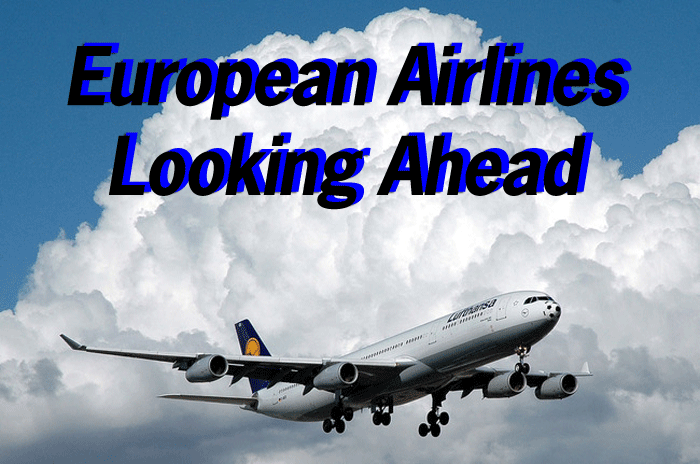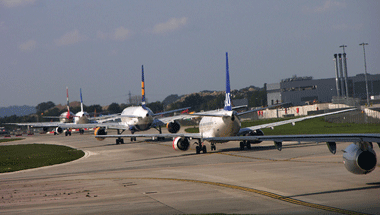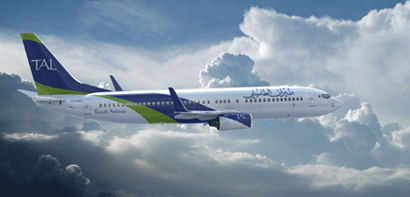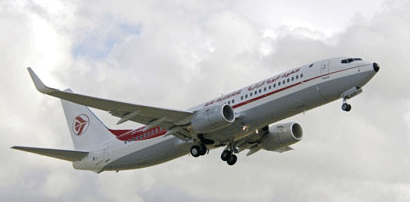
Recent announcement that
BA/IB are merging brings into focus the airline business in Europe.
Here ACNFT senior contributing editor Gordon
Feller casts a wider net with an overview/outlook of the airline business
in Europe as 2009 draws to a close. In this special report, “FY08”
refers to the most recent financial year ending: September 2008 for
EasyJet; December 2008 for Lufthansa, Iberia and SAS; and March 2009
for Air France_KLM, BA and Ryanair.
The European airline industry is highly
vulnerable to external shocks such as falling traffic demand, oil
price fluctuation, adverse regulation and industrial action. Downward
pressure on margins has barely been reduced by the stabilization in
traffic demand during Q309, which was viewed by many as having only
a temporary effect. Seasonally weak demand from October to March will
put continuous pressure on earnings that have already been significantly
impaired due to persistently weakened yields. Capacity is to be further
reduced to improve the load factor.
Airlines’ efforts on cost-cutting
have provided breathing space for them in this severe downturn. However,
it is insufficient to bring earnings out of distress solely on the
merit of rigorous internal cost controls.
Despite being generally well covered
for immediate financial obligations, airlines’ cash flows will
need to be enhanced to meet substantial capital expenditure requirements
in the medium term, otherwise they will be forced to raise more debt
to fund such needs — leading to a further deterioration of credit
ratios in the absence of any meaningful improvement in operating margins.
Historical peak leverage ratios and weak interest coverage ratios
are inevitable at end of 2009.
The highly leveraged capital structure
of many airlines is not sustainable, neither is a dependence on internally
retained cash flows, as longer term sustainability is driven by fundamental
demand growth. Analysts anticipate no early return of airlines’
financial strength, due to the absence of a sustained improvement
in real consumer spending power and premium traffic demand. Outlook
on the European airline industry remains negative for the next 12-18
months.
Despite some major European economies
(France and Germany) having announced that they were officially out
of recession in August, European economies overall continue to be
overshadowed by high unemployment, sluggish business activities and
low consumer confidence. The European airline industry continues to
struggle under such gloomy conditions, experiencing extremely weak
profitability in the summer of 2009 — normally the most buoyant
calendar season — with traffic down by 4% and yield down 17%
on summer 2008.
In September 2009, the International
Air Transport Association (IATA) revised its forecast on net losses
in the global airline industry to USD11bn for 2009 from the USD9bn
forecast in June, more than doubling its original forecast in March
of a USD4.7bn loss. In Europe, the network carriers are expected to
make a combined operating loss of EUR2.9bn, according to the Association
of European Airlines (AEA). This would be a new record loss, 50% higher
than the post 9/11 downturn in 2001-2002.
The unprecedented scale of the recession
continues to stretch the limits of the industry. Despite having emergency
plans in place, airlines are not in the driving seat as they have
exhausted the costcutting potential to match revenue shortfalls. A
further stress test will be faced as these challenges persist in the
coming winter. Airlines usually operate on a wafer thin margin, with
only single-digit profitability. Even at their cyclical peak, most
of the network carriers’ profitability was between 5%-10%. During
the current economic crisis, operating margins are being further squeezed
by many aspects — from a significantly weakened revenue stream
driven by poor air traffic demand, and a seriously damaged yield as
a result of the intense competition in price discounting, to a high
operating cost base including growing fuel costs, increased airport
fees and high labor costs.
Many anticipate the accumulated operating
loss amongst the five largest European network carriers — Lufthansa,
Air France-KLM, British Airways (BA), Iberia and SAS — at around
€EUR1.5bn-2bn in 2009, and a return to profitability is not expected
until possibly 2011. Premium fares have declined by between 25%-40%
during the summer of 2009 compared with a relatively moderate decline
of less than 10% for economy fares. Due to the severity of this downturn,
many analysts expect a permanent structural shift of a certain amount
of passengers traveling from premium to economy class, particularly
in the short-and medium-haul routes.
The major low-cost carriers (LCCs) such
as Ryanair and EasyJet are experiencing strong performance compared
with premium passenger-focused network carriers, since their cost-leadership
positioning is paying back under the economic contraction. Growth
is seen in both traffic and revenue as they capture market share as
a result of passengers being increasingly price-sensitive. EasyJet
received a 5% increase in traffic from July to September 2009 versus
the same period the previous year. Ryanair’s traffic volume
over Q309 has jumped by 18% yoy. Both also gained efficiency on load
factors. One can expect both companies to reach financial year-end
2009 (FYE09) with a double-digit growth in revenue.
Since end-2008, many traditional network
carriers have adopted the practice of unbundling service fares from
base air fares, in order to make the base fares more competitive whilst
seeking new sources of revenue in the downturn.
Ancillary revenues, which used to be
mostly associated with LCCs, have been increasingly pursued by network
carriers in 2009. Airlines have become more and more innovative with
regards to the product they offer. Additional revenue has been generated
from additional charges for insurance, in-flight entertainment, additional
check-in baggage, seat selections, loyalty point accelerator, priority
boarding, and use of airport lounges. For example, BA’s series
of cost-cutting and revenue-boosting measures included reducing meals
on medium-haul European routes to charging fees for seat selections,
clearly demonstrating the airline’s desperation in improving
headline numbers. While airlines are under significant pressure to
implement such incremental revenues, these measures have caused considerable
irritation to passengers. However, some of the methods, especially
if they are not truly value-adding, are counter-productive in public
relations terms when a healthier market returns.
The airlines have already cut staff,
deferred marketing expenses, reduced capacity, retired aircraft earlier,
and cancelled or postponed fleet deliveries.
While these initiatives are crucial
to help airlines survive the severe downturn, they would probably
not be sufficient on their own to bring back airlines’ profitability
in the medium term. The industry will also need to make longer-term
adjustments (“Round Two”), which would include improving
fuel efficiency, optimizing finance structure for the fleet, and effectively
renegotiating labor agreements.
When analyzing airlines’ cost
base, look at the cost per available seat kilometre (CASK) excluding
fuel, because the significant volatility in airlines’ fuel cost
is largely influenced by external economic and political factors;
and, if included, it could distort the unit cost figures and become
less meaningful when drawing comparisons between different airlines.
It’s useful to compare the underlying
cost movement between airlines in the past three years. Air France-KLM
is the only company in the sample to experience constant unit cost
reduction during the period, demonstrating a good degree of flexibility
in its cost structure. Lufthansa, Iberia and Ryanair are also maintaining
a certain stability in their cost base. BA’s unit cost, on the
other hand, has fluctuated dramatically between the 2006-2008 analysis
points; and SAS’s cost base keeps increasing — showing
inflexibility in its cost structure. Therefore, both BA’s and
SAS’s baseline cost structure are seen to be more risky.
Airlines’ operating cost structure
typically contains the following six elements: fuel; staff; fees (including
airport handling charges and landing fees); leases; selling and distribution
(S&D); and depreciation and amortization (D&A). The first
three items account for most of the total operating cost ranging between
53% and 80% — with Lufthansa at the lower end, and LCCs at the
top.
Fuel price volatility plays a big risk
in airlines’ cost structure, and is the most heavily-weighted
item in the operating cost structure for airlines like BA and Iberia.
To help mitigate the exposure to rising fuel prices, European airlines
use hedging instruments such as swaps, forward contracts and options.
Airlines are very vulnerable to both fuel price increases over the
medium-term (as airline fuel hedges tend to run out over a one- to
three-year time horizon) and short-term decreases (which can swiftly
put expensive hedging positions out-of-the-money). The latter risk
was crystallized in Q308, when the collapse of the fuel price led
to dramatic losses on out-of-the-money hedging instruments.
Since Q408, some airlines such as Air
France-KLM have temporarily frozen any further hedges to capture the
benefit of the falling fuel prices, which were lower than the hedged
prices. However, the sustained downward trend of the fuel price in
Q109 continued to penalize airlines’ hedging positions that
were locked in some time ago.
Despite the huge losses, airlines resumed
hedging strategies in Q209 when fuel prices started to rise —
to protect against medium-term exposures. Since then, oil prices have
doubled to above USD80 per barrel in October 2009. Some airlines have
now shortened the contract lengths and monitor the market prices more
closely by adopting dynamic hedging. As
a result of such efforts, many airlines’ fuel costs in H109
were almost halved yoy. With a persistent rise in prices, expect to
see re-imposed fuel surcharges by airlines that are hoping to be able
to pass on some of the cost increases.
Overall, expect the burden of fuel costs to significantly ease, and
their share in total operating costs to fall in 2009. This will be
helped by the 20% appreciation of the euro and 15% appreciation of
sterling against the U.S. dollar from March to October — providing
a welcome boost to European airlines’ jet fuel buying power.
Consequently, amongst the five largest European airlines, around EUR2bn
in fuel bills is expected to be saved in 2009. Nevertheless, the risk
of a medium-term increase in fuel prices could very well coincide
with a recovery in traffic and revenue, thereby limiting the positive
impact any recovery may have on profitability.

Staff costs are composed of salaries,
training costs, and employee benefits (including pensions) for
both ground staff and cabin crew. Apart from temporary labor contracts
and outsourcing, most of the staff costs are considered a fixed-cost
element — driven primarily by the number and structure of
the staff base, and partially by inflation. This is the cost item
over which an airline has relatively more control; hence it is
the preferred area where airlines look for cost-savings in a downturn.
However, powerful labor unions, meaningful strike action, and
sometimes legacy pension issues that cannot be ignored, keep posting
challenges to implementing savings in this area. Amongst its peers,
SAS’s staff costs have the heaviest weight in its operating
cost structure, constantly accounting for over one-third of its
total annual operating cost. The rest of the major network carriers
have staff costs of between 22%-30% of their operating cost.
By contrast, LCCs’ staff costs
were much lighter weighted in their cost structure thanks to their
business model, accounting for between 10%-15% of total operating
costs. The cost impact from headcount movement varies significantly
from company to company. For some airlines, the staff cost movement
is less sensitive to their headcount movement, and the impact
on cost saving from staff reduction is limited. |
|
We've
Seen
Enough Of
The oblique and indecipherable description/phrase
“Sustainability.” Let’s add “shipped
as booked” and “biodynamic” while we are at
it.
All main course restaurant prices over $30.
We are already paying $8 bucks for a side of brussels sprouts
in Manhattan.
Promises that the “next air cargo trade
show” will be better. We hear that one trade show operator,
after delivering less than stellar results for multiple years,
now has changed names and reportedly will try again in 2010.
Hearing that my friends are not doing well or
are sick or deep in debt. We all are in the same boat and must
insist on living a less stressful life and enjoying the blessings
all around us—especially with holidays approaching.
Comparisons that the air cargo business each
month is only less than double digits worse than the month before
or less than 1% better or worse.
Recent word that NCA Cargo, for example, was up 3.7% year on year
for September sounded like a symphony.
Any company professing that it is into “green”
or moving toward a” virtual air cargo product” and
then printing a newsletter and mailing it around. like Traxon
did this week—communicating by sending dead news on dead
trees instead of embracing the digital revolution.
Anybody who prefaces a sentence or sales pitch
or an emotion by saying “In these tough and uncertain times
. . . ”
Geoffrey |
|
|
For example, SAS’s staff
costs were not significantly reduced from 2005 to 2008 whilst its
staff base shrank by almost a quarter during the same period. Iberia,
on the other hand, has demonstrated an effective cost-reduction resulting
from labor redundancy. It managed to decrease the weight of staff
costs in its total operating cost structure by 10 percentage points,
from 34% in 2005 to 24% in 2008, on the back of continuous efforts
to negotiate early-retirement for the more expensive senior crew,
and re-shape its labor base — from a permanent to a temporary
or seasonal base.
To assess their cost efficiency, compare the
unit staff cost (calculated as total staff cost divided by available
seat kilometre (ASK)) amongst the major European airlines. Lufthansa,
Air France-KLM and SAS, with above-average unit staff costs, have
more room for efficiency improvement. Labor (pilot) unions are very
powerful in Europe, and the execution of a painful staff restructuring
could face severe delays or substantial strike consequences. However,
the badly-hit airlines have little choice but to go through the pain.
Towards early-2010, expect to see more announcements regarding headcount
reduction.
In FY08, most of the airlines covered
in this report have experienced a rise of between 7%-11% in fees and
charges by airports, navigation service providers and local authorities.
The extreme cases — represented by EasyJet’s dramatic
fee increase of 33% yoy and Iberia’s fee decrease of 6% —
were a result of policy differences between geographical boundaries.
Spain has the most relaxed policy regarding airport taxes/charges,
whereas the UK represents the opposite case. Despite some government
efforts in Spain, Belgium and Greece to reduce or freeze airport tax
and passenger tax, many places are imposing higher fees — such
as some German airports, the UK government, and the Polish air navigation
services provider, which will further squeeze airline margins in 2009.
The liquidity position for all the major
European airlines is likely be adequate to cover short-term financial
obligations, helped by European capital markets that were accessible
in early 2009 — that allowed airlines to successfully issue
debt to boost their cash reserves. Their liquidity position is also
strengthened by a rigorous discipline — all of the top five
European network carriers have maintained meaningful cash reserves
or committed credit lines. With additional help from generally well-spread
debt maturity profiles, European airlines are in a good position to
cover the cash flow shortfall over the next 12-18 months.
Cash flow from operations (CFO) has
been extremely weak for European airlines in FY09, with SAS even experiencing
negative CFO. Most airlines’ CFO/capex ratios were below 1x
at financial year-end 2008 (FYE08). Since early 2009, European network
carriers have scaled back capex plans for the next two to three years
(whilst LCCs remain aggressive in fleet expansion). However, this
is still considered high compared with the limited cash flow that
has been internally generated.
Due to long fleet lead times, airlines
have to plan for continuous development ahead of recovery, and maintain
investment on fleet upgrades to be able to capture the upside when
a dynamic market returns. The size of fleet investment varies from
airline to airline; since it depends on both the existing fleet conditions
such as aircraft age and model, and an airline’s long-term strategy,
which would include route focus and fuel efficiency.
Owning the oldest fleet (average age
of 11.3 years at December 2008) among the airlines mentioned in this
report, Lufthansa’s order book is significant larger than the
others. This means their earlier issuances totalling EUR1.6bn, which
were primarily used to strengthen the balance sheet for further market
turbulence, may not be sufficient to cover airlines’ investment
needs. European airlines will therefore continue to rely on external
funding to meet such a requirement in the medium term. Free cash flow
(FCF) after dividends and capex is expected to remain negative for
the foreseeable future due to a diverging movement between weakened
cash low generation and less radically reduced capex.
The prolonged economic crisis has shaken
the fundamentals of the European airline industry, which is currently
facing some of the most difficult operating conditions in its history.
It will be a long and slow climb to regain “altitude”
for the airlines, with further uncertainties likely to pose more threats
during the next 18 months.
The major market players such as Lufthansa
and Air France-KLM are capable of battling through the downturn since
they are well-positioned following their earlier market consolidations.
Conversely, other major airlines with underlying problems such as
BA and SAS face further — and more difficult — struggles,
especially in the absence of government aid. Even if these struggling
airlines succeed in surviving the recession, there is a risk that
they shrink dramatically and become “airlines without wings”
by the time the recession is over.
Medium-sized airlines are also in a
precarious position, with the key to their survival most likely to
be the forming of alliances or further consolidation. However, given
current market issues, the pace of any near-term industry consolidation
is likely to be much slower than that seen in the past from 2003-2009.
An inflection point in the downturn has been reached, the reaction
to which will clearly determine airlines’ futures.
Gordon Feller
|






